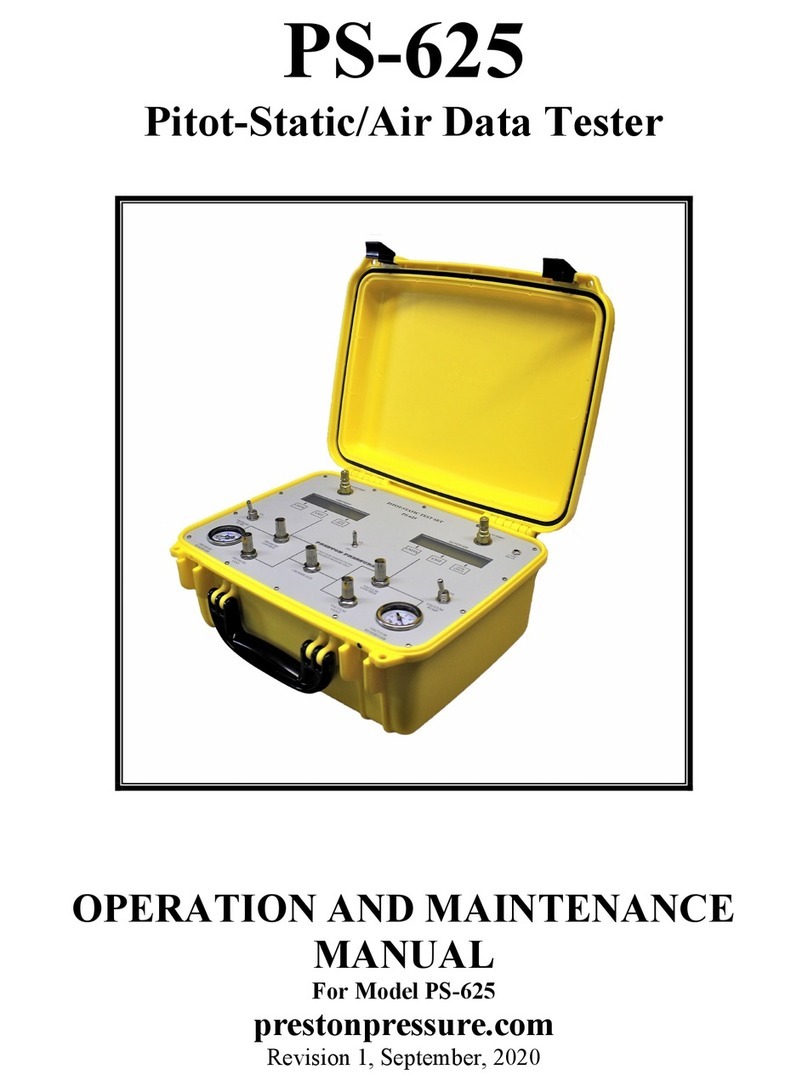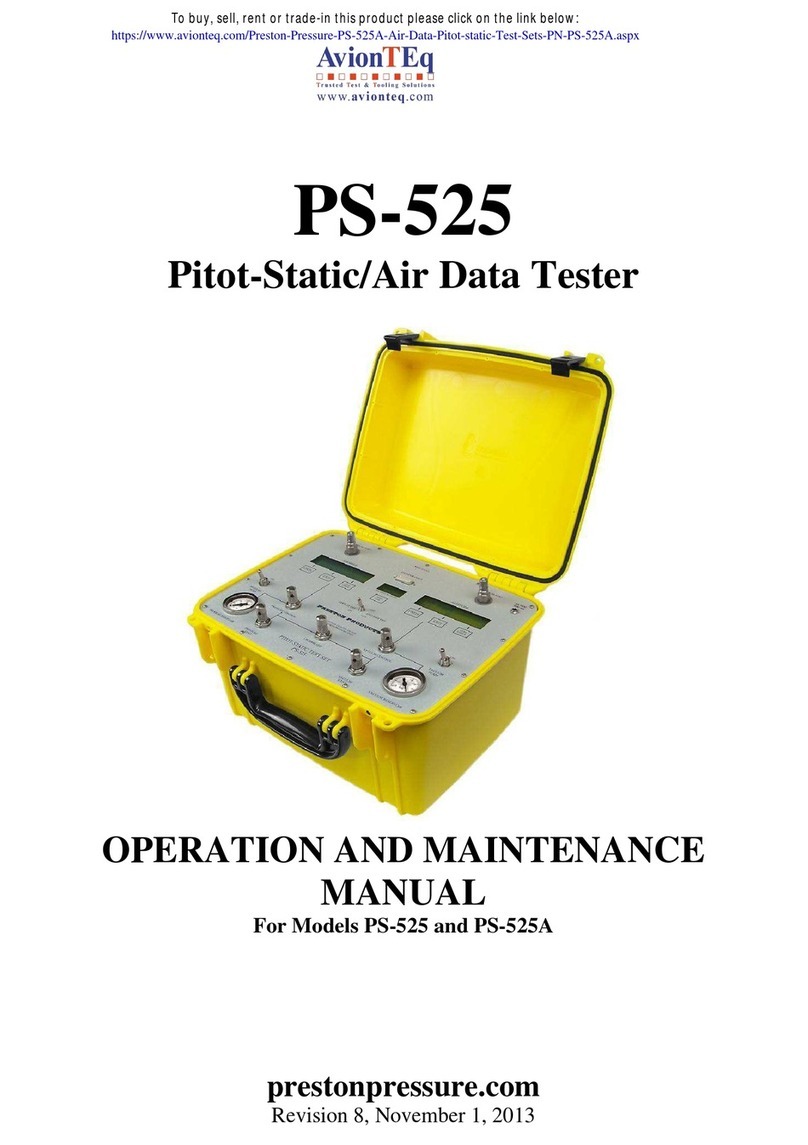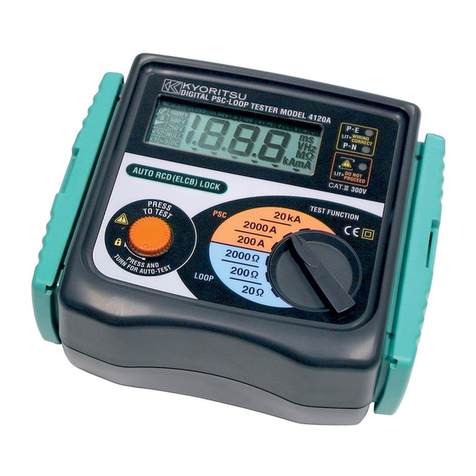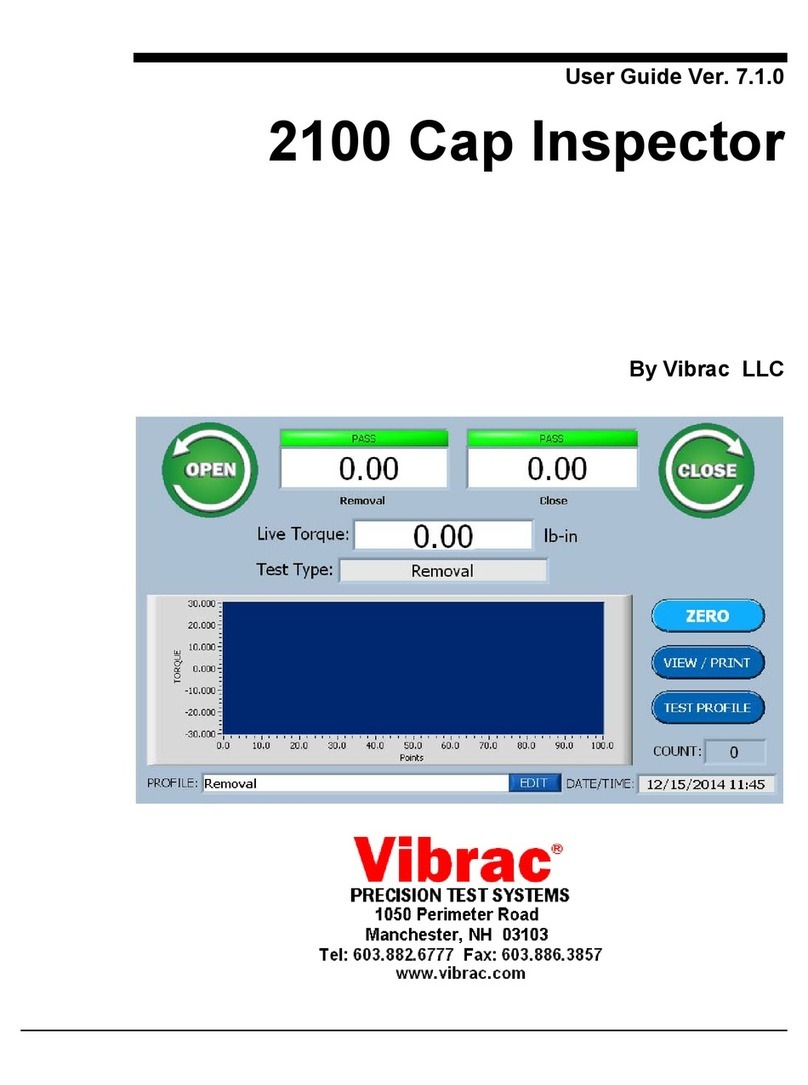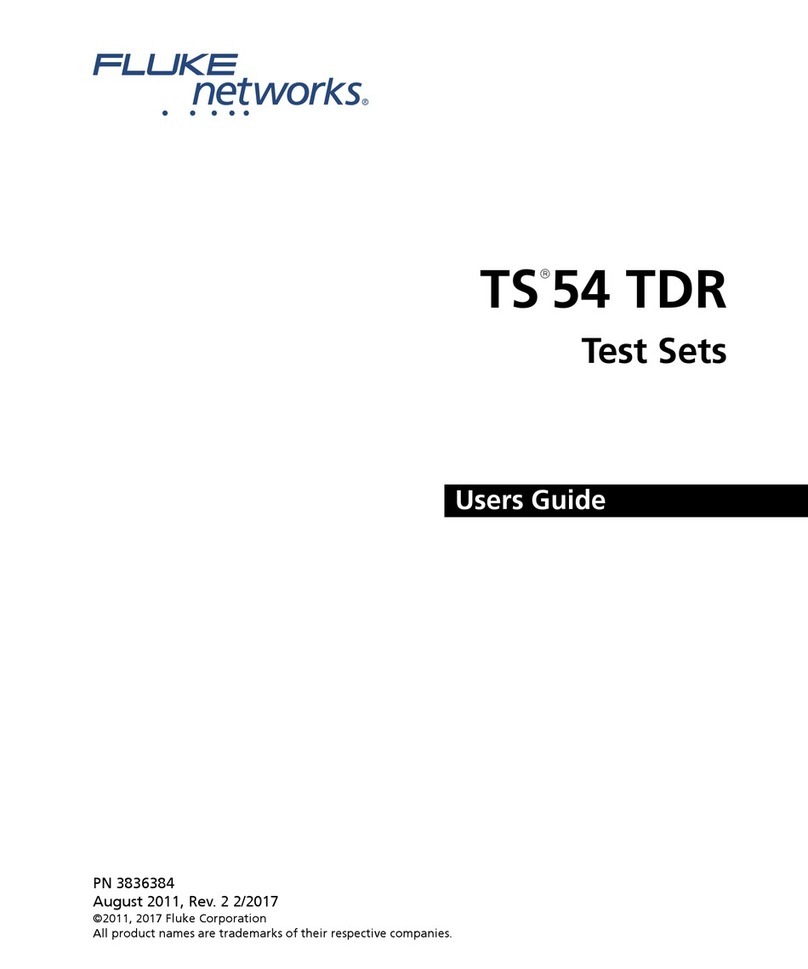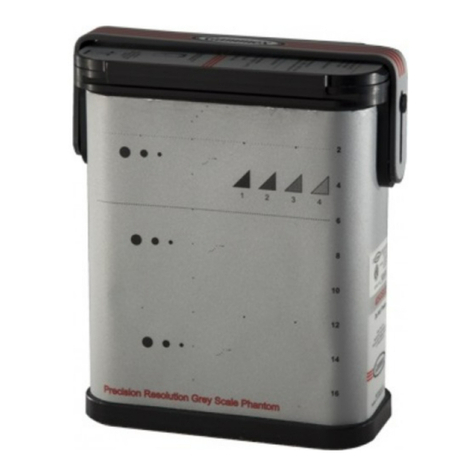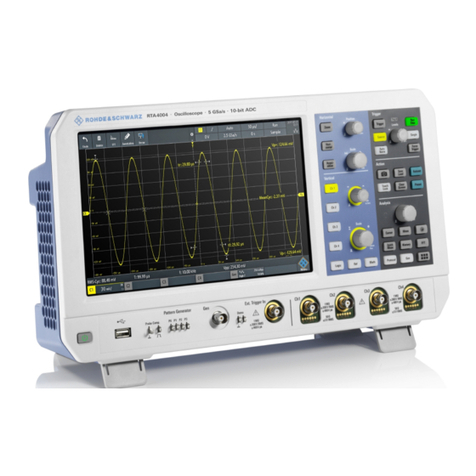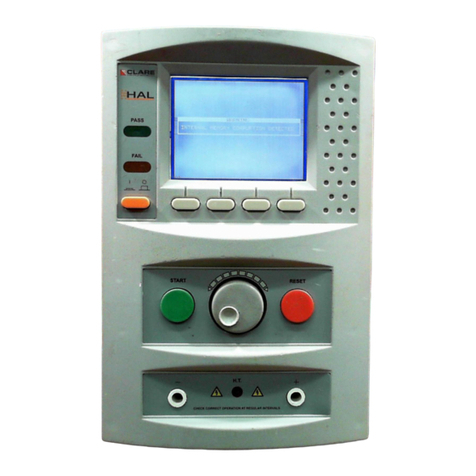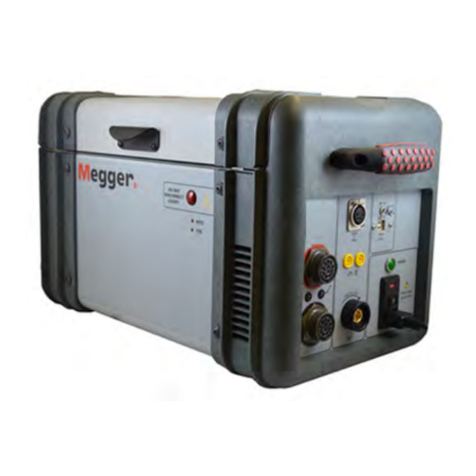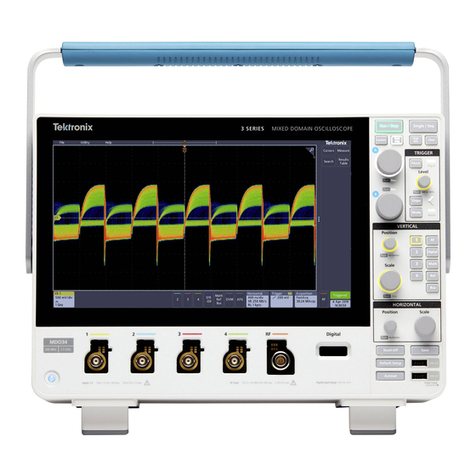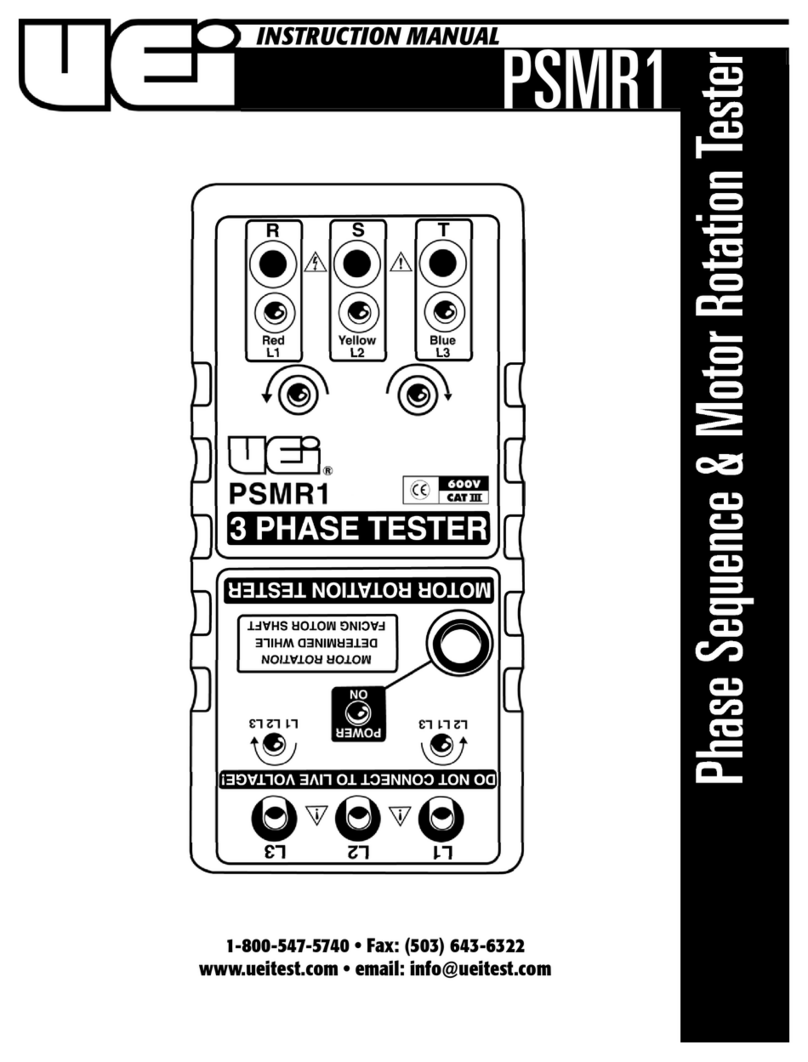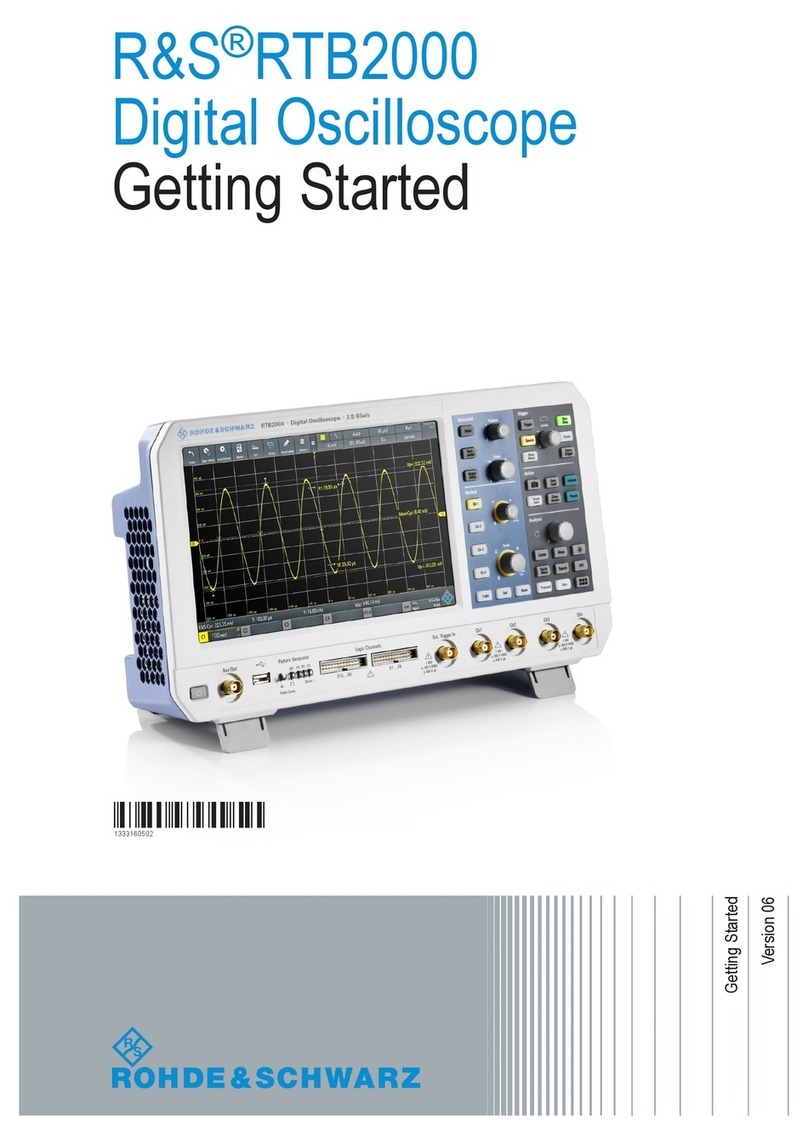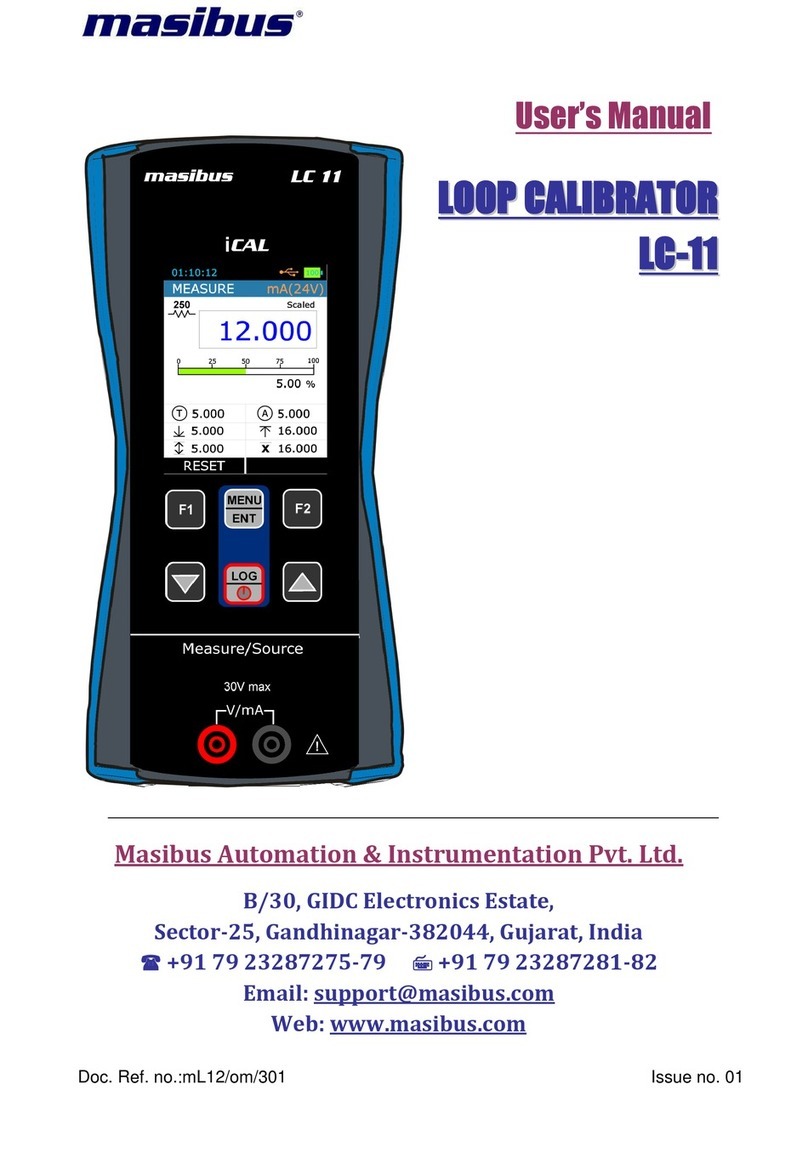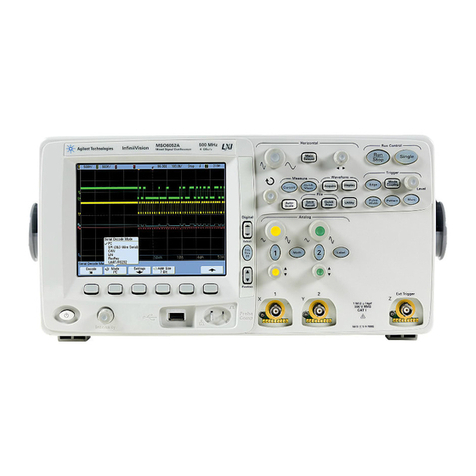PRESTON PRESSURE PS-500 Operating instructions

PS-500
Pitot-Static/Air Data Tester
OPERATION AND MAINTENANCE
MANUAL
For Model PS-500
PrestonPressure.com

1
Revision 0, August 2020
PRESTON PRESSURE LLC
PS-500
USER AND MAINTENANCE MANUAL
TABLE OF CONTENTS
Page
Warranty and Liability Statement---------------------------------------------------- 2
1. General Information------------------------------------------------------------------- 3
3. Specifications ------------------------------------------------------------------ 4
4. Power Supply ------------------------------------------------------------------ 5
5. Vacuum and Pressure Pumps ------------------------------------------------ 5
6. Front Panel Layout------------------------------------------------------------- 6
2. Theory------------------------------------------------------------------------------------- 8
1. Pneumatic Theory -------------------------------------------------------------- 8
2. Electronic Theory--------------------------------------------------------------- 9
3. Electrical Theory --------------------------------------------------------------- 9
3. Operation -------------------------------------------------------------------------------- 10
1. Preliminary Information ------------------------------------------------------- 10
2. Error Codes ----------------------------------------------------------------------10
2. Pre-testing ----------------------------------------------------------------------- 11
3. Testing Aircraft Pitot System ------------------------------------------------- 11
4. Testing Aircraft Static System ------------------------------------------------12
5. testing the Aircraft Pitot and Static systems simultaneously ------------- 13
6. Using the E.P.R. Function ---------------------------------------------------- 13
4. Calibration Procedures ---------------------------------------------------------------- 14
1. Altimeter Calibration ---------------------------------------------------------- 14
2. Airspeed Calibration ----------------------------------------------------------- 17
4. Calibration of Reservoir Gauges --------------------------------------------- 18
5. Maintenance Repairs and Troubleshooting --------------------------------------- 19
1. Annual Maintenance ----------------------------------------------------------- 19
2. Troubleshooting ---------------------------------------------------------------- 20
3. Pneumatic Diagram ------------------------------------------------------------ 21
6. Shipping and Storage ------------------------------------------------------------------ 22

2
WARRANTY AND LIABILITY STATEMENT
Preston Pressure LLC warrants its products against defects in workmanship and material
under normal, intended use for a period of two years from the date of purchase. The
battery is warranted for a period of 90 days from the date of purchase. Valves are
warranted for a period of 180 days.
Preston Pressure’s limit of liability shall be to repair or replace the product at their
discretion. Transportation shall be pre-paid to the Preston Pressure factory or authorized
service facility. Preston Pressure shall not be liable for any consequential damage
expense.
This warranty shall be void if the product has been repaired or altered in any way that
adversely affects its performance or reliability. This warranty shall be void if the product
has been subject to abuse, misuse, contamination, negligence, accident, shipping damage,
or improper operation.
Preston Pressure reserves the right, at its own discretion, to make changes in materials,
designs, finish, or specifications, without obligation to install or incorporate such changes
in products previously manufactured.
Preston Pressure reserves the right to revise this manual and to make changes to content
from time to time in the content thereof, without obligation to notify any person of such
revision.
This device complies with part 15 of the
FCC Rules. Operation is subject to the following
two conditions: (1) This device may
not cause harmful interference, and (2) this
device must accept any interference received,
including interference that may
cause undesired operation.

3
CHAPTER 1
GENERAL INFORMATION
Description of the PS-500 Pitot-Static Test Box
The PS-500 Air Data, pitot-static test box is a digital display tester used to test aircraft
altimeters, airspeed indicators, pitot-static systems, and other vacuum and low-pressure
devices. This test box incorporates transducer sensor technology that is largely immune
to the failures and costly repairs associated with analog instruments.
The PS-500 is battery powered and portable. The vacuum and pressure sources are
derived from independent internal pumps, and each has its own reservoir, thus
eliminating the complexity and maintenance of an additional pressure/vacuum selector
valve. The tester can simulate pressure and vacuum suitable for up to 35K ft and 650
Knots.
The PS-500 measures altitude in feet and meters. Airspeed is displayed in miles-per-hour,
kilometers-per-hour, and knots. Vacuum and pressure are also selectable in various units
of measure, including inches Hg, milliBars, mm Hg, and Psia.
Pressure Sensors
The sensors used in the PS-500 test box are proprietary transducer sensors. The pitot
sensor is not a differential pressure sensor as is most typically used. Instead, the pressure
information from the static sensor is sent digitally to the airspeed’s microprocessor,
where it is subtracted mathematically from the pitot pressure, thus giving the differential
pressure value. This design eliminates several components, with their associated costs
and maintenance.
The sensor has an overpressure rating of 10 times the normal range.

4
PS-500 SPECIFICATIONS
Digital Altimeter:
Display Range: -2000 to 35,000 feet (-610 to 10,700 meters)
Vacuum Pump Range: -2000 to 35,000 feet (-610 to 10,700 meters)
Resolution: from -2000 to 20,000 feet resolution is in 1-foot increments
from 20,001 to 30,000 feet resolution is in 2-feet increments
all metric resolution is in 1-meter increments
Temperature range: 32 degrees F to 120 degrees F (0 C to 50 C)
Altitude units: Feet or Meters
Other Measurement Units:
inHg (inches of mercury): 0.295 to 32.48 in increments of 0.01
mBar (milli bars): 10 – 1100 in increments of 0.1
PSIA (pounds/square inch): 0.145 to 15.95 in increments of 0.01
mm HG (millimeters of mercury): 7.5 – 825 in increments of 0.1
Digital Airspeed:
Range: 18 – 650 Knots, 34 –1204 KPH, 21 – 748 MPH, 0.00 – 1.00 Mach (Mach at altitude of 0ft only)
Resolution: 1 MPH, 1 KPH, 0.1 Knot, or 0.01 Mach
Temperature range: 32 degrees F to 120 degrees F (0 C to 50 C)
Other Measurement Units:
inHg (inches of mercury): 0.295 to 56.10
mBar (milli bars): 10 – 1900
PSI (pounds/square inch) 0.145 to 27.55
mm HG (millimeters of mercury): 7.5 – 1425
E.P.R. (engine pressure ratio): 0.07-6.00
Display Type: LCD Size: Altimeter and Airspeed: 99 x 24 mm
Physical Dimensions: 12.25”D X 15”L X 9.75”H (31x38x24.5 cm)
Weight: approximately 15 lbs (6.8 Kg)
Power Source:
External: 12 VDC (from a 110/220 VAC adaptor)
Internal: 12 VDC (from internal rechargeable battery)
Current draw: 540 mA with all systems operating
Other Features:
Leak test feature: 2 minutes, selectable down to 30 seconds
VSI (vertical speed indicator)
Note: The PS-500 does NOT have the precision required to test RVSM altimeter
systems.

5
Power Supply
The PS-500 power supply consists of an external transformer with an output of 12 volts
DC. This supply is plugged into the round connector on the front of the tester. The
transformer charges the 12-volt gel-cell lead acid battery that is internal to the PS-500.
The battery enables the test box to be used in a portable fashion without a need for
external power while the tester is in operation. The test box can be used while charging, if
so desired, and may be mounted in any position or angle.
A battery monitoring circuit is also incorporated. The display will flash a “Low Battery”
warning when the battery voltage is near 9 volts.
The useable charge duration of the battery will vary, depending on how long the vacuum
and pressure pumps are left on. In order to obtain maximum charge durability, as well
as extend pump and battery life, it is recommended that the pumps be left on only
for the amount of time needed to charge their respective reservoirs, as shown in the
gauges. Then the pumps should be cycled on and off as needed. When used properly,
the user should be able to obtain several hours of operation directly from the battery
before needing to re-charge. In factory tests, with a fully charged battery, the battery
lasted for over 8 hours when powering only the displays.
Vacuum and Pressure Pumps
The vacuum side uses two pumps, connected in series to achieve a vacuum level required
for high altitude tests. The pressure side uses one pump, which is sufficient to reach all
the pressures necessary for normal pressure tests.
Vacuum and Pressure pumps should not be
allowed to run continuously. Toggle the
switches as needed to re-charge the reservoirs
as seen on the vacuum and pressure gauges.

6
FRONT PANEL LAYOUT
Front Panel Description
The front panel’s Altimeter buttons function as follows:
The UNITS button is used to toggle between the various units of measurement available
from the vacuum/altimeter section. (Altitude – feet, Altitude – meters, mBar, mmHg,
inHg, PSIA)
The EXIT button is used to exit out of the leak check mode.
The LEAK CHECK button is functional only when in the Altimeter mode. Pressing this
button will begin a 120 second timer, and the display will also show the gain or loss of
altitude experienced during the displayed time period. If the operator wishes to select a
different length of time, the Leak Check button may be pressed repeatedly, which will
cause a reduction in the timer counter in 30-second increments. The timer will not toggle

7
above 120 seconds nor under 30 seconds. Pressing the Units button will start the counter
and display the leakage.
The front panel’s Airspeed buttons function as follows:
The UNITS button is used to toggle between the various units of measurement available
from the pressure/airspeed section. (Airspeed – MPH, Knots, KPH, mBar, mmHg, inHg,
PSIA, EPR)
NOTICE! The Mach airspeed is only accurate at the altitude of 0 feet (sea level)!
The EXIT button is used to exit out of the leak check mode.
The LEAK CHECK button is functional only when in the Airspeed mode. Pressing this
button will begin a 120 second timer, and the display will also show the gain or loss of
airspeed experienced during the displayed time period. If the operator wishes to select a
different length of time, the Leak Check button may be pressed repeatedly, which will
cause a reduction in the timer counter in 30-second increments. The timer will not toggle
above 120 seconds nor under 30 seconds. Pressing the Units button will start the counter
and display the leakage.

8
CHAPTER 2
THEORY
The PS-500 test box consists of two vacuum pumps linked in series, one pressure pump,
reservoirs for the pressure and vacuum, a system of metering valves, and digital displays
for indicating altitude, airspeed, and various other pressure measurements, based on
pressures sensed in the sensor transducers.
Pneumatic Theory
Metering valves allow the operator to control the rate of flow of the air from the pressure
or vacuum sources, exiting out through the vacuum and pressure ports. The vent valves
allow for metering the produced vacuum or pressure back into the atmosphere. One
Crossbleed valve permits the operator to isolate the pressure and vacuum sides, or to
allow the balancing of pressures, or even to reverse the normal flow of pressures.
The two round gauges allow the operator to monitor the level of pressure or vacuum that
is stored in the tester’s reservoirs. The switch corresponding to the pump for each
reservoir should be toggled to increase the reservoir’s level of vacuum or pressure as
needed. For maximum pump and battery life, do not leave pumps on continuously!
When the operator wishes to simulate an altitude, the Crossbleed, Vacuum, and Vacuum
Vent valves are gently closed. The vacuum pump is then energized until sufficient
vacuum is in the reservoir, as indicated on the Vacuum Reservoir Gauge. How much
vacuum will be needed depends on the desired altitude and is also affected by how long

9
the tubing and lines are between the test box and the altimeter. The vacuum and
pressure reservoir gauges serve only as general references of reservoir vacuum and
pressure; they are not used in the actual calibration of any instrumentation, and do
not require calibration. Once sufficient vacuum is obtained in the reservoir, the pump is
turned off, and the Vacuum Valve is gently opened to allow air to be suctioned into the
system through the vacuum port. Once sufficient altitude simulation is obtained, the
Vacuum Valve is gently closed. Reduction in altitude is accomplished by gently opening
the Vacuum Vent Valve and allowing atmospheric air pressure to enter into the lines.
If the operator needs to go to an altitude below atmospheric pressure, pressure must be
introduced into the pressure reservoir. Opening the Crossbleed Valve will enable pressure
to flow from the pressure reservoir to the altimeter. Open the Crossbleed valve, and then
the Pressure valve to pressurize the vacuum side.
When airspeed is to be simulated, the Crossbleed, Pressure and Pressure Vent valves will
first be closed until the operator establishes a pressure build-up in the pressure reservoir
by turning on the pressure pump. Then the Pressure Valve will be gently opened,
allowing air pressure to flow through the pressure port to the airspeed indicator. To
reduce pressure, the Pressure Vent valve is opened to leak the air pressure into the
atmosphere.
Electronic Theory
The main circuit board of the PS-500 incorporates all the electronics for the altimeter and
airspeed displays. The power for the altimeter and airspeed circuits is regulated from 12
VDC to 5 VDC and 3.3 VDC.
The sensors used in the PS-500 test box are proprietary. The pitot sensor is not a
differential pressure sensor as is most typically used in airspeed measurements. Instead,
the pressure information from the static sensor is sent digitally to the microprocessor
where it is subtracted mathematically from the pitot pressure, thus giving the differential
pressure value. This design eliminates several components with their associated costs and
maintenance. It also allows the Altimeter side to be used at any altitude with the
Crossbleed valve closed, without damaging the airspeed sensor.
Warning: Even though the pressure sensors will not be damaged due to a high
differential pressure between the vacuum and pressure sides, damage can still occur
in external instruments connected to the test box.
Electrical Theory
The internal gel-cell lead-acid battery provides the power to the PS-500 test box. The
battery is charged via the power connector on the front of the test box. Full charging time
is about 10 hours. The test box can be used while it is being charged.

10
CHAPTER 3
OPERATION
Preliminary Information
Prior to using the PS-500 tester the user should become familiar with the unit by reading
this manual and operating the tester independently of any other attached devices.
For greater accuracy, the tester should be powered on for 10 minutes before use.
The test procedures described in this manual are general in nature, for reference
use only. The operator may substitute these procedures with others, as applicable to the
tests to be performed, or according to other specific documentation.
Error codes display as follows:
The display will indicate “Too Cold” or “Too Hot” if the sensor temperature is below
32F or 0C, or above 122F or 50C. Beyond these limits the accuracy should not be
trusted.
Altitude displays “Too High” if it exceeds 35,500 feet.
“Inverse Pressure” will be indicated on the airspeed side if the static pressure exceeds
the pitot pressure by more than approximately 0.1 mbar. Due to its independent
pressure and static sensors, no damage will occur to the tester due to inverse pressure.
However, damage could occur to any system attached to the tester, therefore the
warning is to alert the user of the condition.
“Max Speed” will be indicated on the airspeed side if the pressure exceeds the
equivalent of 650 knots. Due to independent pressure and static sensors, no damage
will occur to the tester from this condition. However, damage could occur to any
system attached to the tester, therefore the warning is to alert the user of the
condition.
“Low Battery” will blink on displays if the battery voltage is less than approximately
9 volts.
Pre-Testing
Pre-test the static system of the PS-500 test box according to the following steps:
1. Ensure the PS-500 is not connected to any external hoses or devices.
2. Close the Vacuum Control, Vacuum Vent, Pressure Control, and Pressure Vent
valves. Open the Crossbleed valve.
3. Turn on the power, and then turn on the Vacuum Pump switch until the Vacuum
Reservoir gauge reads -15 inHG or greater vacuum.

11
4. Open the Vacuum Control valve to make the Altimeter section climb. This climb
may be done rapidly without damage to the sensor.
5. When the Altimeter reads at least 18,000 feet, gently close the Vacuum Control
valve.
6. Wait for 2 minutes or more for the internal pressure to stabilize. Note: a rapid
climb will not damage the tester. However, the internal tubing needs time to
contract due to the applied vacuum, and this will give the appearance of a small
leak for the first 2 minutes or more. Rapid temperature changes will also mimic a
leak.
7. Perform a leak check to monitor the leak rate. Verify that the PS-500 does not
leak exceeding 100 feet per minute. Write down the leak rate for future reference.
(Subtract this value from the total leak rate when testing the aircraft, to arrive at
the aircraft’s leak rate.)
8. Open the Vacuum Vent valve to bring the test box back to ground (ambient)
pressure.
Pre-test the pressure system of the PS-500 test box according to the following steps:
1. Turn on the power to the PS-500.
2. Ensure the PS-500 is not connected to any external hoses or devices.
3. Close the Vacuum Control, Vacuum Vent, Pressure Control, Crossbleed valve,
and Pressure Vent valves.
4. Turn on the Pressure Pump switch until the Pressure Reservoir gauge reads 10
PSI or more.
5. Open the Pressure Control valve to make the Airspeed section climb. This climb
may be done rapidly without damage to the sensor.
6. When the Airspeed reads at least 300 knots, gently close the Pressure Control
valve.
7. Wait for about 15 seconds for the internal pressure to stabilize. Activate the leak
check function to monitor the leak rate. Verify that the PS-500 does not leak
exceeding 2 knots per minute. Write down the leak rate for future reference.
(Subtract this value from the total leak rate when testing the aircraft, to arrive at
the aircraft’s leak rate.)
8. Open the Pressure Vent valve to bring the test box back to ground (ambient)
pressure.
Testing Aircraft Pitot System Only
NOTICE! The Mach airspeed reading is only accurate at the altitude of 0 feet (sea level)!
1. Turn on the power to the PS-500.
2. Connect the Pressure Port to the aircraft Pitot system.
3. Close Pressure Control, Pressure Vent, and Crossbleed valves. Open Vacuum
vent valve.

12
4. Turn Pressure Pump switch on until the Pressure Reservoir indicates 10 PSI or
more.
5. Gently open Pressure Control valve until desired speed(s) are achieved.
6. Compare the airspeed of the PS-500 box to the airspeed indicated in the aircraft.
7. Go to approximately 75% of the maximum airspeed of aircraft indicator (or the
speed specified by the manufacturer). Close the Pressure Control valve and after
allowing a few seconds for stabilization, perform a leak check. The pitot system
should not leak more than two knots per second, plus the leakage previously noted
in the pressure system pre-test.
8. Gently open the Pressure Vent valve to return the pitot pressure to ambient
pressure.
Testing of Aircraft Static System (independent from the pitot system)
Note: If the previous pitot system test indicated an excessive leak, do not proceed until
that leak is repaired. Damage to aircraft airspeed indicator could result.
1. Turn on the power to the PS-500.
2. Disconnect the static line to the airspeed indicator and cap the line.
3. Connect the Vacuum Port to the aircraft static port. Set the aircraft altimeter to
29.92 inHg (1013.3 mB).
4. Close Vacuum Control, Vacuum Vent, Pressure Control, and Pressure Vent
valves. Open Crossbleed valve.
5. Operate the Vacuum Pump switch until a desired level of vacuum is seen on the
Vacuum Reservoir gauge (generally -15 to -20 inHG). Turn Pressure Pump switch
on until the Pressure Reservoir indicates 10 - 15 PSI or more.
6. Gently open the Vacuum Control valve to cause the altitude to climb.
7. DO NOT exceed the climb rate of the aircraft VSI indicator, or the airspeed
indicator limits. The VSI is a very delicate instrument.
8. Climb to the desired altitude(s) per the test to be performed.
9. Close the Vacuum Control valve, and after allowing a few seconds for
stabilization, compare the aircraft altimeter with the test box.
10. When at the appropriate altitude (generally 18,000 feet) perform a leak check. If
the static system shows leakage, be careful to not exceed the VSI rate. Be
prepared to open the Vacuum Control valve if needed, to prevent excessive VSI
indication.
11. Gently open the Pressure Vent valve to return the system pressure to ambient
pressure. Do not exceed the VSI or airspeed indicator limits.
12. Re-connect airspeed indicator static line and do a leak check test.
Note: if an altitude lower than ambient pressure is desired, do steps 1-4 above. Gently
open the Pressure Control valve to pressurize the system, thereby causing the
altimeter to decrease in altitude. Open the Vacuum Vent valve to return to ambient
pressure.

13
Testing the Aircraft Pitot and Static systems simultaneously
Note: First ensure pitot system does not leak by performing Pitot system test on page 14.
1. Turn on the power to the PS-500.
2. Connect the Vacuum Port to the aircraft static port, and the Pressure Port to the
aircraft pitot port. Set the aircraft altimeter to 29.92 inHg (1013.3 mB).
3. Close Vacuum Control, Vacuum Vent, Pressure Control, and Pressure Vent
valves. Open Crossbleed valve.
4. Operate the Vacuum Pump switch until a desired level of vacuum is seen on the
Vacuum Reservoir gauge (generally -15 to -20 inHG). Turn Pressure Pump switch
on until the Pressure Reservoir indicates 10 PSI or more.
5. Gently open the Vacuum Control valve to cause the altitude to climb.
6. DO NOT exceed the climb rate of the aircraft VSI indicator, or the airspeed
indicator limits. The VSI is a very delicate instrument.
7. Climb to the desired altitude(s) per the test to be performed.
8. Close the Vacuum Control valve, and after allowing a few seconds for
stabilization, compare the aircraft altimeter with the test box.
9. When at the appropriate altitude (generally 18,000 feet) perform a leak check. If
the static system shows leakage, be careful to not exceed the VSI rate. Be
prepared to open the Vacuum Control valve if needed, to prevent excessive VSI
indication.
10. To display an airspeed, close Crossbleed valve and gently open Pressure valve
until desired airspeed is indicated. Close Pressure valve.
11. To return system to ambient pressure, ensure Crossbleed valve is open. Then
gently open the Pressure Vent valve to return the system pressure to ambient
pressure. Do not exceed the VSI or airspeed indicator limits.
Note: if an altitude lower than ambient pressure is desired, do steps 1-4 above. Gently
open the Pressure Control valve to pressurize the system, thereby causing the
altimeter to decrease in altitude. Open the Vacuum Vent valve to return to ambient
pressure.
Using the E.P.R. function
The EPR function is used to test engine pressure ratios. This ratio is the mathematic result
of: High Pressure/Low Pressure. The PS-500 test box will display the low pressure, the
high pressure (both in PSI), and the resulting EPR. To use the EPR function, proceed as
follows:
1. Turn on the test box.
2. Close all of the valves, including the Crossbleed valve.
3. Connect the Vacuum port to the low pressure to be tested.
4. Connect the Pressure port to the high pressure to be tested.
5. Cycle through the Units on the Airspeed side until in the EPR mode. Read the
EPR values displayed.
Note: Do not exceed 16.75 PSI on the high pressure side, to avoid sensor damage.

14
CHAPTER 4
CALIBRATION PROCEDURES
The recommended calibration interval for the PS-500 test box is one year. If at any
time during regular use the unit becomes unreliable or out of correct operating
calibration, it must be repaired and/or re-calibrated before continuing its use.
The PS-500 test box is easy to calibrate. There are 5 set points used in the calibration of
the altimeter side. Calibrating at multiple setpoints enables the altimeter to have a greater
degree of accuracy, allowing it to self-correct to the nearest calibrated set point.
The altimeter side should normally be calibrated first, as the airspeed side reads the static
pressure through the altimeter circuitry. However, if the altimeter side has been tested
and found satisfactory, the airspeed side can be calibrated at any time.
Note: the calibration factors are stored in the microcontroller’s EEPROM memory. This
memory does not need battery back-up. The calibration will not be lost if the unit’s
battery is disconnected or replaced.
PS-500 Altimeter Side Calibration Procedures
1. Apply power to the PS-500 and allow unit to warm up for a minimum of 10 minutes.
2. Gently close the Vacuum Control valve, Vacuum Vent valve, and Crossbleed valve.
3. Connect a known altitude pressure standard to the Vacuum Port.
4. Set the PS-500 altimeter measurement units to read in mbar by pressing the Units
button.
5. Press the Exit and Leak Check buttons simultaneously. The display will change to:
Enter Cal Mode?
6. Press the Leak Check button to proceed with calibration or select the Exit button to
exit out of the calibration mode without any changes being made.
7. At this point the display will read:
Go To 0 Feet
Next

15
8. Now the display will show
XXX
In YY
Where XXX is the sensed altitude and YY is the internal correction factor currently
stored in the calibration memory.
Using the pneumatics of the PS-500 or an attached pressure standard, go to a
pressure of 0 feet (referenced from 29.92 inHg), as read from the pressure standard.
When the altitude is stable for approximately 30 seconds, note the altitude displayed
on the PS-500 display in calibration mode.
If the displayed altitude is higher or lower than the standard, press the Exit or Leak
Check button as needed to incrementally change the altitude to be equivalent to the
standard.
As the altitude is adjusted, note that the displayed correction factor also changes. Use
this to fine-tune the altitude as close as you can to the standard.
When the PS-500 altitude matches the standard as close as possible, wait another 30
seconds to ensure that the internal mathematical filtering corrections have been done.
If satisfied with the results, press the Units button to proceed to the next calibration
level.
Note: Allowable error tolerances are as follows (these are the allowable errors per
AC43 Appendix E, not the accuracy of the PS-500):
Altitude
+/
-
Error
Altitude
+/
-
Error
-1000
0
500
1000
1500
2000
3000
4000
6000
8000
10000
12000
5
5
5
5
6
7
7
8
10
15
20
22
14000
16000
18000
20000
22000
25000
30000
35000
40000
25
27
30
32
35
38
45
51
57
Note: Make a written note of each calibration correction value. In the very rare
case that a calibration factor is lost from the memory, it can be re-programmed
without a complete calibration procedure. The correction values can also serve as a

16
record to see if the sensors are drifting with age. A good place to keep the calibration
correction values is in this manual.
9. After pressing the Units button, the display will change to display Go to 10000 feet.
10. Repeat the procedure in step 8 at each requested altitude: 10000, 20000, 30000 and
40000, feet.
11. After entering the calibration value of the highest altitude, pressing the Units button
will change the calibration to the VSI calibration mode. Select a vertical descent speed
(5,000 feet is suggested) on the calibration test equipment and activate it. The display will
indicate the calculated VSI value. Adjust if needed by pressing the Exit or Leak Check
buttons. When finished, press the Units button. The VSI calibration value will be saved.
12. After the VSI calibration has been entered, the display will briefly read
Calibration
Saved
and then re-start in the altitude mode. There is no need to re-cycle power.
13. Bring the PS-500 box back down to ground level pressure, then test each calibration
point as specified in the chart. Enter the corrected value at each point. (The correction
chart may be photocopied, cut out, and fixed to the test box for handy reference.)
Maximum allowable error at any altitude is 70 feet. (Generally, a maximum error of less
than 20 feet should be expected.)
PS-500 S/N
FOR TEST
ALTITUDE DISPLAY
ALTITUDE FOR TEST
ALTITUDE DISPLAY
ALTITUDE
-
1000
10000
-500
11000
0
12000
500
14000
1000
16000
1500
18000
2000
20000
3000
22000
4000
25000
6000
30000
8000
35000
Calibrated by: ___________ Date: __________
Next Calibration Due Date: ________________

17
Airspeed Calibration Procedures
1. If not already powered on, apply power to the PS-500 and allow unit to warm up for a
minimum of 10 minutes.
2. Gently close the Pressure Control valve, Pressure Vent valve, and Crossbleed valve.
3. Connect a pressure standard to the Pressure Port. Maintain the altimeter side at 0 feet.
4. Press the Units button to set the airspeed measurement units to read in mbar.
5. Press the Exit and Leak Check buttons. The display will change to:
Enter Cal Mode?
6. Press the Leak Check button to proceed with calibration or select the Exit button to
exit out of the calibration mode without any changes being made.
7. At this point the display will read:
Go to 50 Knots
Next at 0 Feet
Using an attached pressure standard, go to an airspeed 50.0 knots (while always
maintaining the static pressure of 0 feet), as read from the pressure standard.
8. X.X Knots
Enter YY
Where X.X is the sensed knots and YY is the internal correction factor currently stored in
the calibration memory.
9. When the pressure is stable for approximately 30 seconds, note the pressure displayed
on the PS-500 airspeed display in calibration mode.
If the displayed speed is lower or higher than the standard, press the Exit or Leak Check
button as needed to incrementally raise or lower the pressure to be equivalent to the
standard.
As the pressure is adjusted, note that the displayed correction factor also changes. Use
this to fine-tune the pressure as close as you can to the standard.
If satisfied with the results, press the Units button to save the calibration and exit back to
the mBar mode.

18
10. After the calibration point has been entered, the display will briefly read
“Calibration Saved” and then exit the calibration mode.
11. When a satisfactory calibration is obtained at this test point, go through each test
point in the following chart and enter the corrected value at each point. (The correction
chart may be photocopied, cut out, and fixed to the test box for handy reference.)
12. Make a written note of the calibration correction value. In the very rare case that a
calibration factor is lost from the memory, it can be re-programmed without a complete
calibration procedure. The correction value can also serve as a record to see if the sensors
are drifting with age.
Maximum allowable error at any airspeed is 2 Knots. (Generally, a maximum error of 1
Knot should be expected.) The airspeed has only one calibration point.
PS-500 S/N
FOR TEST
AIRSPEED DISPLAY
AIRSPEED FOR TEST
AIRSPEED DISPLAY
AIRSPEED
20 Kts
275 Kts
40 Kts
300 Kts
60 Kts
325 Kts
80 Kts
350 Kts
100 Kts
375 Kts
120 Kts
400 Kt
s
140 Kts
425 Kts
160 Kts
450 Kts
180 Kts
500 Kts
200 Kts
550 Kts
225 Kts
600 Kts
250 Kts
650 Kts
Calibrated by: ___________ Date: _________
Next Calibration Due Date: _______________
Calibration Notes:
Do not forget to wait the minimum of 10 minutes before calibrating.
The calibration procedure can be entered only when the mbar mode is selected.
Do not forget to check bead colors in the air pressure reservoir/dryer. If they are
pink or clear, it is time to change the unit to avoid a build-up of moisture in the
pressure system. Replacement air dryers can be purchased at many hardware
stores, or on the internet (do a search for “mini desiccant dryer”).
Calibration of Reservoir Gauges
The reservoir gauges are for reference only, and do not need calibration. The operator
merely references these gauges as an indication of how much reserve pressure or vacuum
there is in the reservoirs, and as a guide to know when to turn on the pump(s).

19
CHAPTER 5
MAINTENANCE REPAIRS AND TROUBLESHOOTING
Note: Refer to the Theory of Operation section as a reference on how the various systems
function.
Annual Maintenance
The following annual maintenance is recommended:
1. Check color of beads in air reservoir/dryer. Change if pink or clear. The dryer is a
common in-line dryer used in small air compressor systems. A new dryer can be
purchased from Preston Pressure, or an internet search for “mini inline desiccant air
dryer” may lead to an alternate source.
2. Feel fuses to verify tightness. If a fuse feels loose, remove the fuse, squeeze fuse clip
slightly and re-install fuse.
3. Tug on motors to verify motors are mounted tightly. If play is noticed, disconnect
battery and connectors. Remove bottom assembly panel by removing the four screws
holding the bottom assembly. Tighten the motor mount screws and re-assemble.
4. Verify vacuum reservoir tank is mounted tightly.
5. Verify electrical connectors are seated completely.
6. Verify battery holding clamp is tight.
7. Verify switches and valves on front panel are mounted tightly.
8. Test for leaks.
9. Perform calibration checks and re-calibrate if necessary.
Table of contents
Other PRESTON PRESSURE Test Equipment manuals
